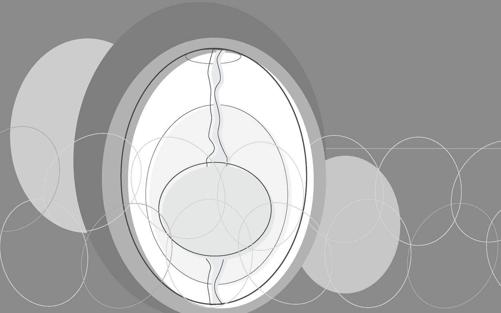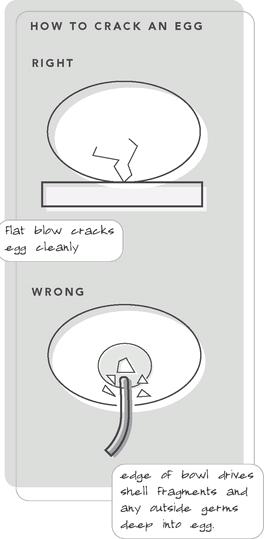I'm Just Here for the Food (40 page)
Read I'm Just Here for the Food Online
Authors: Alton Brown
Tags: #General, #Courses & Dishes, #Cooking, #Cookery

Wooden spoon
Hollandaise Takes a Holiday
I’ve suffered more failed hollandaise sauces than I can count. So I don’t make it anymore. Instead, I make a lemon curd that is like hollandaise sauce, except that it looks better, tastes better, and clings to food better than any hollandaise I’ve ever made. And unlike the classic version, this sauce is cooked.
Application: Simmering
Place an inch of water in the pot, cover, and bring to a boil.
Place the egg yolks in the metal bowl and whisk vigorously until they lighten in texture and color. This is important, as it partially denatures (or unwinds) the proteins in the yolks, which will prevent them from curdling when faced with the lemon juice.
Add 2 teaspoons of the lemon juice, ¼ teaspoon of the cayenne, a pinch of salt and all of the sugar. Whisk until smooth.
When the water boils, reduce the heat to medium-low and place the bowl on top of the pot.
Whisk the egg mixture gently but continuously for about 7 minutes, or until it moves like very heavy cream (the whisk will leave a definite trail in the liquid).
Remove the bowl from the pot and set it on a dish towel (for stability).
Whisk the butter into the mixture 1 piece at a time, allowing each piece to melt almost completely before adding the next.
Taste, adjust seasoning, and serve immediately.
Yield: about 1 cup
Note:
The most difficult thing about making hollandaise sauce is that it easily curdles. That is, the proteins become over-coagulated. Sugar molecules interfere with the process of curdling, so I invite a few to the party just to keep the peace. Low, controlled heat and frequent whisking do the rest.
Software :
5 egg yolks (the fresher, the better)
2 teaspoons lemon juice, plus more
to taste
¼ teaspoon cayenne pepper, plus
more to taste
1 teaspoon salt
1 teaspoon sugar (see
Note
)
1 stick unsalted butter, cut into
tablespoon-size chunks
Hardware :
Small pot
Heavy metal mixing bowl large
enough to sit on top of the pot
with a couple of inches of lip
to spare.
Balloon whisk
Dish towel
Red Onion Tomato Jam
This is a tasty accompaniment to garlicky bread and fried calamari. It’s also great on meatloaf instead of the traditional ketchup coating.
Application: Sautéing , Simmering
Heat a small sauce pan over medium-high heat and add the oil. Add the onions and shallots and toss to coat with the oil. Reduce the heat to low and allow the onions and shallots to sweat and caramelize for about 15 minutes, stirring often. They should be very soft and sweet-tasting. Add the tomatoes, brown sugar, vinegar, and tomato paste. Stir to combine and cook until the mixture is thick and bubbly. Add the stock and reduce to thick bubbly consistency again. Season with salt and pepper. Remove from heat and set half the mixture aside. Purée the other half and fold it back into the reserved mixture. Fold in the basil.
Yield: about 2 cups
Software :
2 teaspoons olive oil
2 cups red onions, sliced
Lyonnaise-style
¼ cup shallot, finely diced
2 cups seeded and diced tomatoes
3 tablespoons brown sugar
4 tablespoons balsamic vinegar
2 teaspoons tomato paste
1 cup beef stock
Kosher salt
Freshly ground black pepper
1 to 2 tablespoons basil, cut into
fine chiffonade
Hardware :
Small sauce pan
Rubber spatula
Stick blender
Mignonette Sauce/Vinaigrette
Mignonette is fancy oyster-dippin’ sauce. It can also form the base of a vinaigrette dressing. In this application, boiling serves to release flavors, soften material, and intensify flavors. Acetic acid boils at a higher temperature than water so by boiling the solution, the vinegar flāvor will be intensified.
Application: Boiling/Simmering
For the mignonette:
Place the vinegar, shallots, Champagne and white pepper into a 2-cup glass measuring cup and zap it in the microwave for 2 minutes. Carefully remove from the microwave, stir and place into the refrigerator to cool completely, approximately 1 hour. Serve on raw oysters on the half shell…always in fashion.
Yes, on high, what other power is there?
For the vinaigrette:
Once the sauce has cooled completely, measure 1½ times the amount of olive oil as you have mignonette. For example, if you have 1 tablespoon of mignonette left over to make the vinaigrette, you’ll need 1½ tablespoons of olive oil. Slowly whisk the oil into the mignonette or buzz up the mignonette in a blender and gradually drizzle in the olive oil.
Yield: Approximately 1 cup of mignonette
Software :
1 cup champagne vinegar
2 tablespoons finely chopped
shallots
1 tablespoon Champagne
½ teaspoon white pepper
Olive oil
Hardware :
Cutting board
Chef’s knife
2-cup glass measuring cup
Whisk or blender
Chocolate Mint Sauce
I also call this the “Elixir of Life.” You may choose simply to pour this into shot glasses and cut out all that ice-cream nonsense.
Application: Boil
Place cream, corn syrup, butter, cocoa, and salt into a 3-quart saucepan and bring to a boil. Remove from heat, add the bittersweet chocolate and allow to sit, undisturbed, for 5 minutes. Add the peppermint extract and whisk gently until well combined. Serve immediately over ice cream or other dessert.
Yield: 2 cups sauce
Software :
1 cup heavy cream
¼ cup light corn syrup
3 tablespoons butter
1 tablespoon Dutch-process cocoa
¼ teaspoon kosher salt
6 ounces bittersweet chocolate,
chopped fine
1 teaspoon peppermint extract
Hardware :
Cutting board
Chef’s knife
Plunger cup
3-quart saucepan
3-quart saucepan
Whisk
Dutch-process cocoas are slightly redder in color than natural cocoa and disperse more easily in liquids.
Could you use semisweet? Yes, but there’s already a lot of sweetness in this concoction, so you may want to think twice. That said, you don’t want to go crazy and use unsweetened chocolate either.
CHAPTER 9
Eggs
Eggs are the plastic of the kitchen. There’s very little they can’t do.

Eggs-cetera
Legend has it that each fold on a chef’s toque, that tower of power that perches upon the pates of chefs worldwide, represents a method by which eggs may be cooked. A tall tale? Yes, but I’d buy it. The humble chicken egg is arguably the most versatile food on earth. It can be fried, poached, roasted, coddled, scrambled, pickled, boiled, and broiled. Were it not for the emulsifying power
of the fatty yolk, we would have neither mayonnaise nor hollandaise, nor
would we have custard. Were it not for the amazing foaming flexibility of the white’s unique proteins, there would be no mousse, no meringue, no soufflé.
In short, were it not for eggs, life as we know it would not exist—in the kitchen, or anywhere else for that matter.

All this power and versatility can lead to confusion when one simply wishes to cook an egg for eggs’ sake. I finally came to terms with egg cookery when I realized that eggs are essentially liquid fish.
35
I admit, this is not an especially appealing idea, but it makes a lot of sense when put into practice.
Like fish, eggs don’t like to be pushed around thermally. When exposed to the right temperature for the right amount of time, their proteins denature and then coagulate into a nice soft gel. But when pushed too far or for too long, these proteins turn into little chemical fists and wring all the moisture right out. That’s why scrambled eggs often appear (and taste) like yellow bits of rubber floating in water.
Unlike eggs, fish have the advantage of being solid, which means they may be dredged, battered, or breaded. This gives the cook the ability to apply high heat and create a golden brown exterior. I have yet to see this work with eggs, though I’ve heard that recent advances in zero-gravity cooking look promising.
So, here are some rules for fish and eggs: fried eggs, eggs over easy, eggs sunny-side up, scrambled eggs, omelets, quiche, flan, custards,
36
and egg-based sauces such as hollandaise.
1. Heat a non-stick pan over the lowest heat your cook top can muster.
An 8-inch pan is best for 1 to 2 large eggs.
2. Add a small amount of fat to the pan using a basting brush for thin, even coverage. You can use either butter or oil or (my preference) a combination of the two. Why add fat to a non-stick pan? For one thing, I like to be able to slide my egg around to shape it while it cooks and to be able to flip it, and that requires lubrication. (Non-stick doesn’t necessarily mean slick; see The Right Pan.) A little fat also helps to conduct heat evenly into the surface of the egg. Fat also improves flavor. Say you want your eggs soft and creamy but you also want a taste of golden brown—that nutty sweetness that only shows itself when serious BTUs are involved. No problem. You can develop that flavor before the eggs even show up. Simply melt a pat of butter over medium heat. As soon as the foaming subsides, turn the heat up and hold it there just until you catch a whiff of something like roasted nuts. Kill the heat and let the pan cool down. Then cook the eggs over low heat. The browned butter will coat your eggs with Maillard goodness.
THE RIGHT PAN
Because they’re high in protein, eggs can stick mightily to cookware. So when eggs are on the menu, grab a good nonstick pan. Eggs also hate high heat, so you’ll need a pan that’s a good conductor and is free of hot spots. As usual, a good place to find such cookware is at a restaurant supply store. Choose a thick pan that is heavier than it looks, and has a textured (not super-smooth) surface; it will last longer and release food easily. If you’re cooking for two, an 8-inch pan is fine, but a 10-inch is even better. And remember, most commercial pans are oven-safe; just don’t put them under the broiler.
